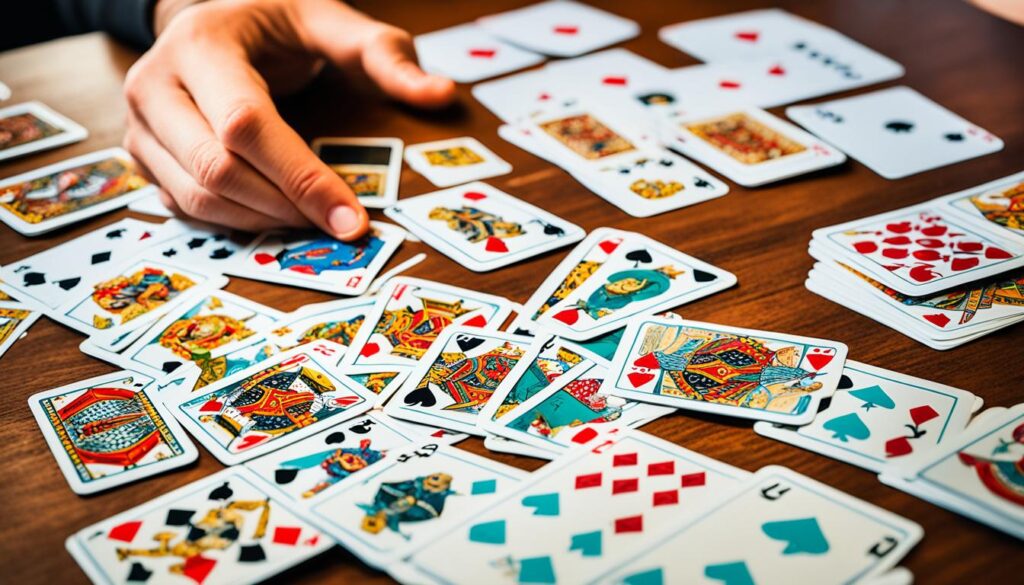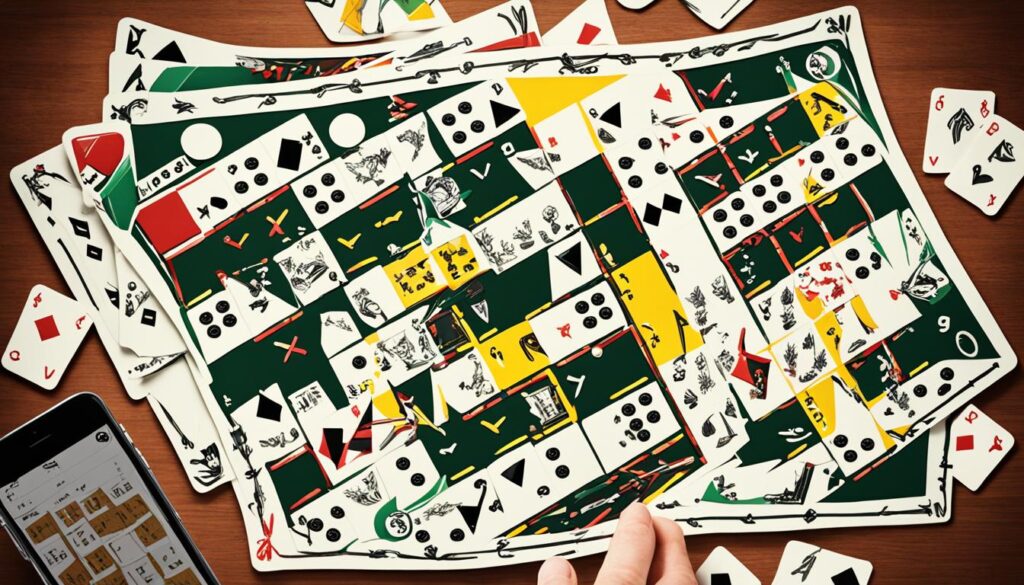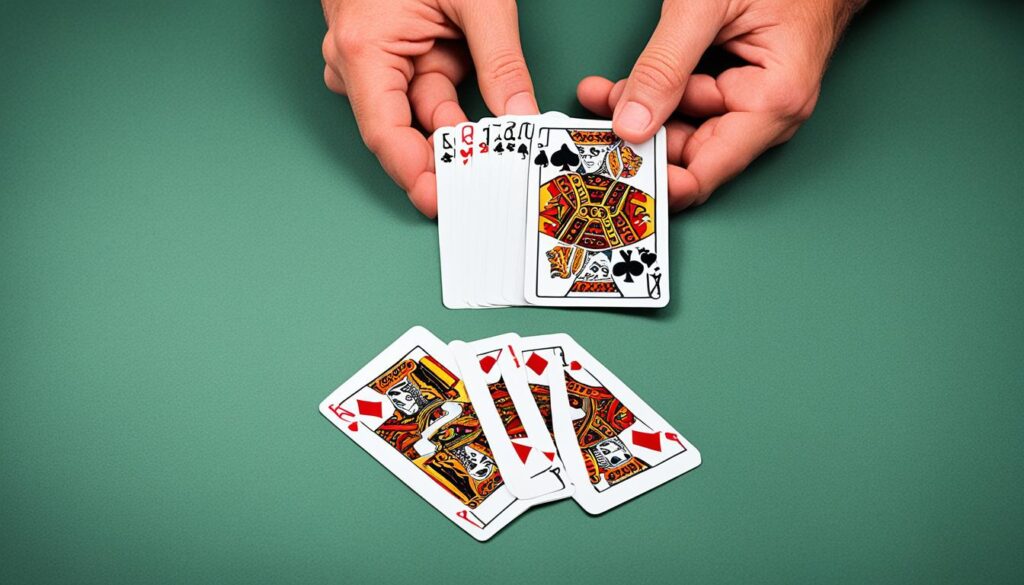Welcome to our guide on how to play rummy in Hindi! Whether you’re a beginner or looking to brush up on your rummy skills, we’ve got you covered. Rummy is a popular card game that has been enjoyed for generations. By following our step-by-step guide, you’ll learn the rules and strategies to improve your chances of winning. Let’s dive in and discover the exciting world of rummy in Hindi!
Playing rummy in Hindi can be a fun and rewarding experience. It’s a game that requires both skill and strategy. Whether you’re playing with family and friends or in online tournaments, knowing how to play rummy in Hindi will give you an edge. So, let’s get started and explore the world of rummy in Hindi!
What is Rummy?
Rummy is a popular card game that has been enjoyed by players for generations. It is played with a standard deck of cards and can be played by 2-6 players. The objective of the game is to be the first player to get rid of all the cards in hand. Rummy requires players to form sets and runs of cards to create melds, which are combinations of cards that can be laid down on the table.
Creating melds is the key to success in rummy. A set is a group of three or four cards of the same rank but different suits, while a run consists of three or more consecutive cards of the same suit. For example, a set can be three 5s of different suits, while a run can be 4, 5, 6 of hearts. Melds can be created by picking up cards from the stockpile or by taking cards that other players have discarded.
Rummy is a game that requires strategy and skill to win. Players need to pay attention to the cards being discarded by other players and make the right decisions about which cards to pick up or discard. It is important to remember that the objective is not only to get rid of all the cards but also to minimize the points in hand.
“Rummy is a card game that combines strategy, skill, and a bit of luck. It is easy to learn, yet challenging to master. The game provides endless entertainment and is enjoyed by players of all ages.”
The rules of rummy may vary slightly depending on the specific variation being played, but the basic objective and gameplay remain the same. The game can also be played in Hindi, with rummy rules in Hindi being easily accessible for players who are more comfortable with the language.
Next, we will explore how to play rummy in more detail, including the specific rules and strategies to improve your chances of winning. Whether you are new to the game or a seasoned player, our guide will provide you with valuable insights and tips to enhance your rummy skills.
Rummy Versus Other Card Games
| Game | Number of Players | Deck of Cards | Objective |
|---|---|---|---|
| Rummy | 2-6 | Standard Deck | Get rid of all cards |
| Poker | 2-10 | Standard Deck | Win the pot by having the best hand |
| Bridge | 4 | Standard Deck | Score points by winning tricks |
How to Play Rummy?
To play rummy, each player is dealt a certain number of cards, and they need to arrange them into sets and runs. Players take turns, and the game continues until one player gets rid of all their cards or the stockpile runs out.
Rummy is a popular card game that requires skill, strategy, and a bit of luck. It can be played with 2-6 players, and the objective is to create valid melds of sets and runs. Sets are groups of three or more cards of the same rank but different suits, while runs are sequences of three or more consecutive cards of the same suit.
Let’s take a closer look at how to play rummy:
- Dealing the Cards: The dealer shuffles the deck and deals a certain number of cards to each player, depending on the variation being played. In games with 2-4 players, each player receives 13 cards. In games with 5-6 players, each player receives 10 cards. The remaining cards are placed facedown to form the stockpile.
- Forming Sets and Runs: After the cards are dealt, each player must arrange their cards to form valid melds of sets and runs. A set can be formed by grouping cards of the same rank from different suits. For example, a set can consist of the 3 of hearts, 3 of spades, and 3 of diamonds. A run can be formed by arranging cards in consecutive order of the same suit. For example, a run can consist of the 4, 5, and 6 of diamonds.
- Draw and Discard: On their turn, a player must draw one card from either the stockpile or the discard pile. After drawing a card, the player must decide if they want to keep it or discard a different card. The discarded card is placed face-up on the discard pile.
- Declaring Rummy: If a player has formed valid melds of sets and runs and has no remaining cards in hand, they can declare rummy. This means they have won the game and all other players receive penalty points based on the value of the cards remaining in their hands.
- Stockpile and Shuffle: If the stockpile runs out before a player declares rummy, the discard pile is shuffled and placed facedown to form a new stockpile. Play then continues with the next player.
| Term | Definition |
|---|---|
| Set | A group of three or more cards of the same rank but different suits. |
| Run | A sequence of three or more consecutive cards of the same suit. |
| Stockpile | The facedown pile of cards from which players draw during their turns. |
| Discard Pile | The face-up pile of cards that have been discarded by players. |
| Meld | A valid combination of sets and runs formed by a player. |
Now that you know the basics of how to play rummy, it’s time to gather your friends or family, grab a deck of cards, and start playing. Remember to strategize, observe your opponents’ moves, and aim to create valid melds to increase your chances of winning. Happy rummy playing!

Number of Players in Rummy
Rummy is an exciting game that can be enjoyed by 2-6 players. The number of players participating in a rummy game can greatly influence the dynamics and strategies involved. With more players, the game becomes increasingly challenging and requires different strategies to achieve victory. On the other hand, playing with fewer players gives you more control over the game and allows for a faster-paced experience.
Let’s take a closer look at the various player combinations and how they affect the gameplay:
2-3 Players:
Playing rummy with just 2 or 3 players provides an intimate gaming experience where each player has a greater chance of winning. In this scenario, a standard deck of playing cards (52 cards) is used. The objective is to be the first player to discard all your cards by forming valid sets and runs. The fewer the players, the more cards each player receives at the beginning of the game.
4-6 Players:
When playing rummy with 4-6 players, two decks of playing cards (104 cards) are combined to accommodate the larger group. Each player receives fewer cards compared to games with fewer players. The increased number of participants makes the game more challenging and requires players to adapt their strategies accordingly. With more cards in play and increased competition, the game becomes a test of skill, strategy, and quick decision-making.
To summarize, the number of players in a rummy game impacts the gameplay and strategies employed. Whether you choose to play with a smaller or larger group, the objective remains the same – form valid melds and be the first player to discard all your cards. Now that you have an understanding of the player dynamics in rummy, you are ready to explore the exciting world of this classic card game.
Rules of Rummy
When playing the rummy game, it’s important to understand the rules that govern the gameplay. While some variations may have slight differences, the fundamental objective remains the same – to create melds of sets and runs. Let’s dive into the key rules that will guide you in your rummy journey.
Creating Melds
The primary goal of rummy is to form melds, which are sets and runs of cards. A set consists of three or four cards of the same rank, while a run consists of three or more consecutive cards of the same suit. For example, a set could be comprised of three 7s, and a run could be formed with the 8, 9, and 10 of hearts.
Valid Melds
Each meld must adhere to specific rules to be considered valid. For a set, all cards must have the same rank, but they can belong to different suits. In contrast, a run must consist of consecutive cards of the same suit. It’s important to note that in a run, the Ace can be played before the 2 or as the highest card after the King, but it cannot be used in between. For example, a run can be formed with the Ace, 2, and 3 of spades, but not with the 10, Jack, and Queen of clubs.
Number of Cards
The number of cards required to form a valid meld may vary based on the rummy variation being played. Typically, a set is made up of three cards, while a run requires a minimum of three cards. However, some variations may have additional rules regarding the number of cards needed for specific melds.
Additional Rules
Aside from the basic rules mentioned above, there may be other rules specific to certain rummy variations. These can include rules related to picking cards, discarding cards, and the use of jokers or wildcards. It’s essential to familiarize yourself with these additional rules to play the game effectively and avoid any potential penalties.
Example of a Rummy Game Table (6-Player Variation)
| Player | Cards Dealt |
|---|---|
| Player 1 | 13 cards |
| Player 2 | 13 cards |
| Player 3 | 13 cards |
| Player 4 | 13 cards |
| Player 5 | 13 cards |
| Player 6 | 13 cards |
In a 6-player rummy game, each player is dealt 13 cards to start the game. The remaining cards are placed facedown to form the stockpile, which players draw from during their turns.
Understanding the rules of rummy is crucial for enjoying and succeeding in the game. Now that you have a good grasp of the basic rules, let’s explore the scoring system in the next section.
Scoring in Rummy
When playing the exciting game of Rummy, scoring is an essential aspect that determines the outcome of each round. The scoring system is based on the value of the cards that are not part of valid melds. The objective is to have the lowest score at the end of the game, indicating your success in the game.
In Rummy, the value of each card is determined as follows:
| Card | Value |
|---|---|
| Ace | 1 point |
| Numbered cards (2-10) | Face value (2 points for 2, 3 points for 3, and so on) |
| Face cards (Jack, Queen, King) | 10 points |
To calculate your score, add up the points of the cards remaining in your hand that were not part of a valid meld. The player with the lowest score at the end of the game wins!
It’s important to note that in addition to regular scoring, there may also be bonus points awarded for certain achievements. These achievements can vary depending on the specific variation of Rummy being played. For example, you may receive bonus points for going out (getting rid of all your cards) early in the game or completing a hand without any jokers.
To master the art of Rummy, it’s crucial to develop effective strategies that not only help you form valid melds but also minimize your score. Analyzing the cards in your hand and planning your moves tactfully can greatly improve your chances of winning.

By understanding the scoring system and implementing smart strategies, you can gain an edge over your opponents and emerge victorious in the fascinating world of Rummy!
Types of Hands in Rummy
In rummy, understanding the different types of hands that can be formed is essential to becoming a skilled player. The game involves creating sets and sequences of cards, known as melds, to win.
In a rummy game, there are two main types of hands that players aim to form:
- Sets: A set is a group of three or more cards of the same rank but different suits. For example, a set can consist of three 7s from different suits (7♥, 7♣, 7♠).
- Sequences: A sequence is a group of three or more consecutive cards of the same suit. For example, a sequence can be formed with 5, 6, and 7 of hearts (5♥, 6♥, 7♥).
Each hand has specific rules that players must follow when forming melds:
- Sets: To form a set, players need at least three cards of the same rank but different suits.
- Sequences: To form a sequence, players need at least three consecutive cards of the same suit.
It’s important to note that when forming melds, players cannot use a single card in multiple melds. Each card must be part of only one set or sequence.
Forming valid melds is crucial in rummy, as players need to have all their cards organized into melds to win the game. It requires strategic thinking and careful planning to create the right combinations and declare the game successfully.
Now that you understand the different types of hands in rummy, you’re ready to dive deeper into the world of rummy techniques and strategies. Let’s explore how to use jokers and understand the last card rule in the upcoming sections.

Joker Rules and Order in Rummy
When it comes to playing the thrilling game of rummy, understanding the onus and potential of joker cards is essential. Joker cards serve as versatile components, having the power to substitute for any other card in a meld. This unique ability is especially beneficial for players looking to complete sets and runs, ultimately improving their chances of winning.
However, it’s important to note that there are specific rules governing the use of jokers in rummy. These rules may vary depending on the variation of the game being played, so it’s crucial to familiarize yourself with the specific guidelines of the variant you’re indulging in.
Furthermore, the order in which jokers are used can also vary. Some variations of rummy follow a fixed order while others allow players to decide the order themselves. Understanding the order of jokers is crucial for creating valid melds and maximizing the potential of these wildcard cards.
To gain a better understanding of joker rules and order in rummy, let’s take a look at a couple of examples:
Example 1: Fixed Order
| Order | Joker 1 | Joker 2 |
|---|---|---|
| First Joker | Wildcard | Wildcard |
| Second Joker | Wildcard | Wildcard |
| Third Joker | Wildcard | Wildcard |
In this particular variation, the joker cards are assigned a fixed order. Players must utilize the jokers in a meld starting from the first joker in the order and progressing to the next. Each joker can be used as a substitute for any other card in a meld, making it easier to form valid sets and runs.
Example 2: Player’s Choice
| Order | Joker 1 | Joker 2 | Joker 3 |
|---|---|---|---|
| Player A’s Choice | Wildcard | Wildcard | Wildcard |
| Player B’s Choice | Wildcard | Wildcard | Wildcard |
| Player C’s Choice | Wildcard | Wildcard | Wildcard |
In this variation, players have the flexibility to decide the order in which they will use the jokers. Each player can choose the sequence of jokers that best complements their strategy. This adds an exciting element of decision-making to the game, as each player can strategize and plan their melds accordingly.
Understanding the joker rules and order in rummy is crucial for players who want to excel at the game. By utilizing these wildcard cards effectively and adhering to the specific rules of the variant being played, you can enhance your gameplay and increase your chances of victory.

Last Card Rule in Rummy
In the game of rummy, there is a rule known as the Last Card Rule that players must adhere to when they have only one card left in their hand. This rule requires players to declare that they have reached their last card and are ready to make a move. Failure to follow this rule can result in penalties or even disqualification from the game.
The Last Card Rule is an essential aspect of rummy gameplay as it ensures fair play and maintains the integrity of the game. By declaring their last card, players notify their opponents that they are close to winning and provide an opportunity for strategic gameplay and counter moves.
For instance, if a player fails to declare their last card and their opponents are caught off guard, it can lead to unexpected twists and turns in the game. This can significantly impact the outcome and create a thrilling atmosphere for all players involved.
By adhering to the Last Card Rule, players can engage in strategic planning and utilize their rummy techniques to outsmart their opponents. It adds an element of suspense and excitement as the game reaches its final stages.
Remember, the Last Card Rule is crucial for the smooth flow of the game and ensures that all players have an equal chance to react and strategize. So, whether you’re a beginner or an experienced rummy player, make sure to play by the rules and embrace the excitement of the Last Card Rule!
Advantages of Jokers in Rummy
In rummy, jokers play a crucial role in enhancing your gameplay and increasing your chances of winning. Let’s explore the various advantages they offer:
1. Completing Melds
Jokers can be a game-changer when it comes to completing melds. As versatile cards, they can be used as substitutes for any other card in a set or run. This flexibility allows you to create valid melds more easily and quickly.
2. Flexibility in Forming Sets and Runs
With the help of jokers, you have the freedom to form sets and runs in different ways. Since jokers can represent any card, you can replace missing cards in a sequence or set, making it easier to form valid combinations.
3. Strategic Use Against Opponents
Jokers can also be used strategically to confuse your opponents. By inserting jokers in your melds, you can make it harder for your opponents to predict your moves and develop effective strategies against you. This element of surprise can give you a competitive edge during gameplay.
“Using jokers strategically can keep your opponents guessing and increase your chances of victory.”
By leveraging the advantages of jokers, you can significantly improve your rummy skills and elevate your gameplay. Let’s take a look at a table summarizing the advantages of jokers in rummy:
| Advantages of Jokers in Rummy |
|---|
| Completing melds |
| Flexibility in forming sets and runs |
| Strategic use against opponents |
Conclusion
Playing rummy in Hindi can be a delightful and thrilling experience. By familiarizing yourself with the rules of the game and implementing effective strategies, you can improve your skills and increase your chances of winning. Whether you’re a beginner or an experienced player, rummy offers a stimulating challenge that keeps you engaged and entertained.
Learning how to play rummy in Hindi provides an opportunity for players to connect with the game on a deeper level, ensuring a comfortable and enjoyable gaming experience. With the availability of Indian rummy tutorials and guides, players can access valuable resources to enhance their gameplay skills and grasp the intricacies of the game.
So, if you’re ready to embark on an exciting journey, gather your friends, or join an online rummy platform, and start playing rummy in Hindi today. Discover the joy of melding sets and runs, the thrill of picking the right cards, and the satisfaction of declaring victory. Let rummy immerse you in its captivating world where strategy, skill, and luck intertwine to create an unforgettable gaming experience.